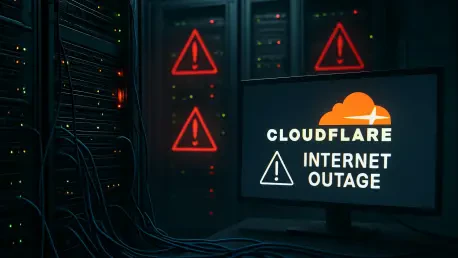In an era where digital connectivity serves as the backbone of daily life, a sudden and widespread internet outage can send shockwaves across the globe, disrupting everything from social interactions to critical business operations with alarming speed. On a recent Tuesday, a major technical failure in Cloudflare’s infrastructure—a cornerstone of internet reliability—caused exactly that, leaving countless users unable to access essential online platforms. Known for safeguarding websites against cyberattacks and ensuring uptime during traffic surges, Cloudflare’s unexpected breakdown affected prominent services like the social media platform X, OpenAI’s ChatGPT, the popular game League of Legends, and even Truth Social. Starting around noon Israel time, the disruption triggered a flood of error messages such as “Internal Server Error on Cloudflare network” for users attempting to connect via mobile apps or desktop browsers. This incident not only highlighted the scale of reliance on such infrastructure but also raised pressing questions about the stability of the digital ecosystem that underpins modern society.
Widespread Impact on Online Platforms
The magnitude of the disruption became glaringly apparent as reports of service interruptions poured in from across the world. By noon Israel time, Downdetector.com had logged over 10,000 user complaints specifically related to X, with the issues breaking down into mobile app failures at 61%, website access problems at 28%, and server connection errors at 11%. This breakdown illustrates how the outage permeated various access points, affecting a broad spectrum of users regardless of their chosen device or platform. Beyond X, other major services also bore the brunt of the failure, with thousands unable to engage with AI tools, online gaming communities, or niche social networks. The sheer volume of affected platforms painted a vivid picture of Cloudflare’s extensive reach within the internet’s framework, underscoring how integral its services are to maintaining seamless digital experiences for millions globally. Such widespread impact serves as a stark reminder of how interconnected and dependent online ecosystems have become on a handful of key providers.
Equally concerning was the immediacy with which the outage disrupted daily routines and business activities. For many, the inability to access critical tools and communication channels meant halted productivity, missed opportunities, and growing frustration. While Cloudflare issued a statement within 15 minutes of the first reports, acknowledging the issue and confirming an ongoing investigation, the absence of a clear root cause or estimated resolution time added to the uncertainty. The affected services spanned diverse sectors, from entertainment and social engagement to professional and technological innovation, revealing the far-reaching consequences of a single infrastructure failure. This event exposed not just technical vulnerabilities but also the broader implications for industries that rely heavily on uninterrupted internet access. As users scrambled for alternatives or waited for updates, the incident highlighted the urgent need for contingency plans to mitigate the fallout from such unexpected disruptions in the digital realm.
Underlying Vulnerabilities in Internet Infrastructure
Delving deeper into the incident, the outage brought to light the inherent fragility of the internet’s underlying systems, where a single point of failure can trigger a domino effect across countless applications. Cloudflare, often operating invisibly to the average user, plays a pivotal role in ensuring online stability, but its breakdown made this role painfully visible. Roughly an hour after the initial disruption, partial recovery was observed in some services like X, suggesting that mitigation efforts were underway. However, without a comprehensive update from the company, full restoration remained uncertain, leaving users and businesses in limbo. This situation emphasized how much of the digital world hinges on the reliability of a few critical providers, whose failures can cascade through the interconnected web of online services. The incident serves as a wake-up call to reassess the robustness of current systems and the risks associated with over-reliance on centralized infrastructure.
Beyond the immediate effects, this event sparked a broader discussion about the systemic vulnerabilities within global internet frameworks. The diverse range of impacted platforms—from social media giants to specialized AI tools—illustrated how a glitch in one provider’s network can reverberate across seemingly unrelated sectors. Such interconnectedness, while a strength in terms of accessibility, becomes a liability when disruptions occur, as there are few immediate alternatives for users to turn to. This outage underscored the pressing need for diversified infrastructure and robust backup mechanisms to prevent similar cascading failures in the future. Stakeholders across industries must now consider how to build redundancy into their systems, ensuring that a single malfunction does not bring entire digital ecosystems to a halt. The narrative emerging from this incident is one of urgency, pushing for innovation in how internet reliability is maintained and protected against unforeseen challenges.
Lessons Learned and Path Forward
Reflecting on the disruption, it became evident that the Cloudflare outage on that Tuesday laid bare significant weaknesses in the fabric of global internet infrastructure. Thousands of users worldwide found themselves cut off from essential services, with outage tracking tools like Downdetector capturing the scale of the impact across various sectors. Despite early signs of recovery in some platforms, the lack of a definitive resolution from Cloudflare at the time left lingering doubts about the stability of online access. This incident acted as a powerful reminder of how dependent society has grown on a small number of critical providers, whose failures can disrupt life on a massive scale. It was a moment that forced a reckoning with the digital landscape’s shared vulnerabilities, urging a collective push toward stronger safeguards.
Looking ahead, the focus must shift to actionable strategies for enhancing resilience against such outages. Industry leaders and technology providers should prioritize the development of decentralized systems and failover protocols to minimize the impact of future disruptions. Collaboration between service providers could foster the creation of shared resources and backup networks, ensuring continuity even when primary systems falter. Additionally, investing in advanced monitoring tools to detect and address issues before they escalate could prove invaluable. This event was a catalyst for change, highlighting the necessity of proactive measures to protect the digital infrastructure that underpins modern life. By addressing these systemic risks now, the internet can evolve into a more robust and reliable foundation for the countless services and interactions it supports every day.









